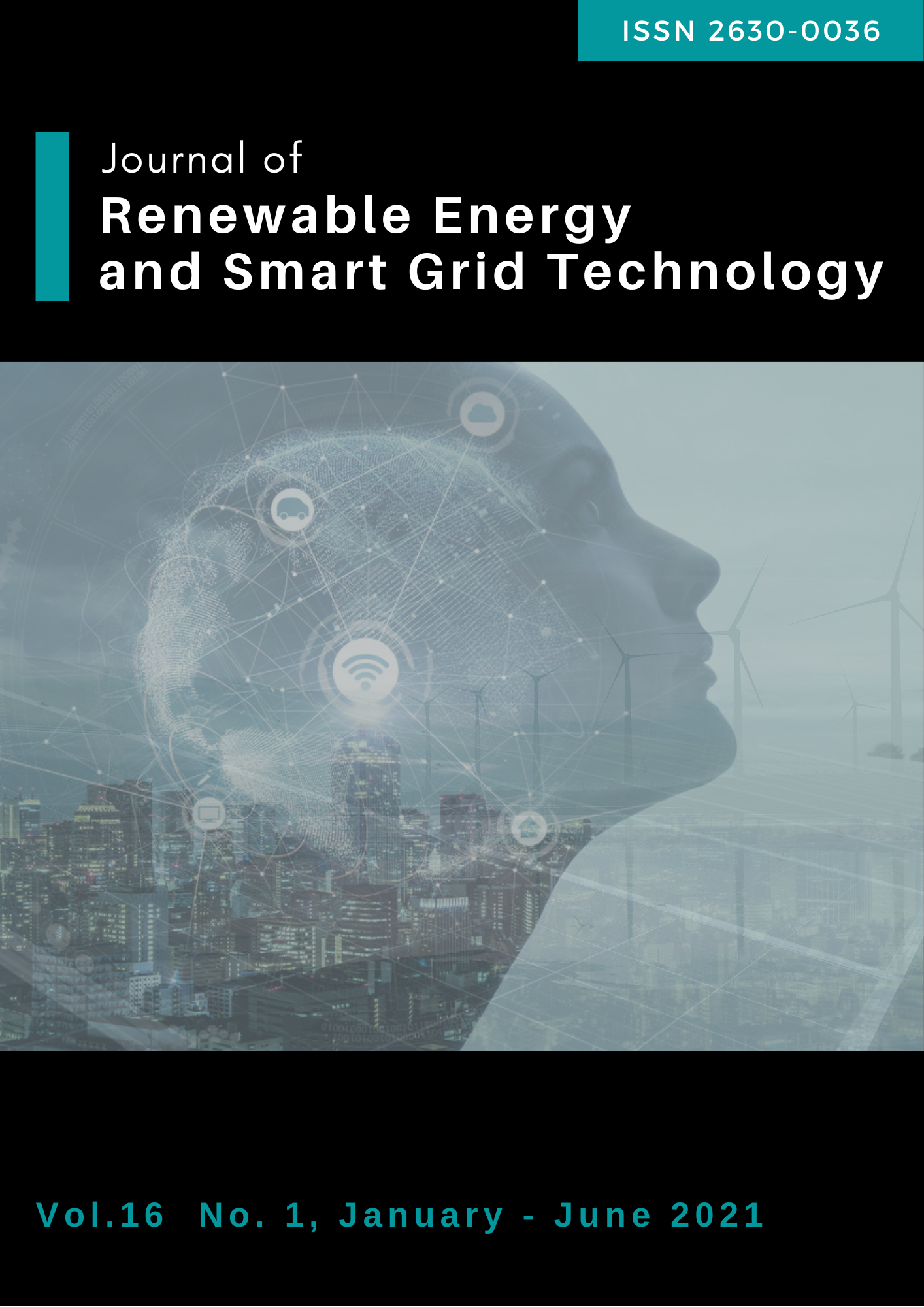RMS/EMT Simulation of Maesariang Microgrid System when Change Operation Mode
Keywords:
RMS, EMT, Simulation, Microgrid, Changing operation mode, Security, Stability, DigSILENT Power FactoryAbstract
This study cation demonstrates the performance of Maesariang Microgrid System (MMGS) during changing operation mode from grid connection to island in 2 cases and from island to grid connection in 2 cases. Stability Analysis (RMS) and Electromagnetic Transient (EMT) simulation by using DigSILENT Power Factory software is used to evaluate MMGS performance during switching the operation mode between grid connection mode and island mode that is the critical period of MMGS for controlling the network security, stability, reliability, and power quality of its service area. The behavior of active power generation from the PV system, the active and reactive power generation, voltage, and frequency from Battery Energy Storage System (BESS) at Maesariang substation in 50 s of the changing mode periods with and without communication time delay is studied for indicating MMGS performance in each simulation case. The simulation result presents that MMGS has impressive performance to manage all studied electrical parameter during changing mode from island to grid connection in all case and grid connection to island in the case that the spare generation power of BESS is higher than the lose incoming power and communication time delay has the unimportant effect to MMGS performance. In the contrary, MMGS performance during changing mode from grid connection to island in the case that the spare generation power of BESS is equal or lower than the lose incoming power is quite terrible and communication time delay are the precious factor to arbitrate the continuously operation or blackout in MMGS.
References
Electricity Generating Authority of Thailand (EGAT). (1970-2019). The peak power demand of Thailand. Retrieved December 28, 2020, from https://www.egat.co.th/index.php?option=com_content&view=article&id=353&Itemid=200
Masson, G. & Kaizuka, I. (2020). Trends 2020 in Photovoltaic Applications. Genval, Belgium: IEA-PVPS T1.
Energy Regulatory Commission (ERC). (2018). Summary purchase status of power plant. Retrieved December 28, 2018, from http://www.erc.or.th/ERCSPP/default.aspx?x=0&muid=23&prid=41
Panwar, L. K., Reddy, S., Verma, A., & Panigrahi, B. K. (2017). Dynamic incentive framework for demand response in distribution system using moving time horizon control. IET Generation, Transmission & Distribution, 11(17), 4338-4347.
Arun, S. L., & Selvan, M. P. (2017). Dynamic demand response in smart buildings using an intelligent residential load management system. IET Generation, Transmission & Distribution, 11(17), 4348-4357.
Wang, X., El-Farra, N. H., & Palazoglu, A. (2017). Optimal scheduling of demand responsive industrial production with hybrid renewable energy systems. Renewable Energy, 100, 53-64.
Schultis, D. L. (2019). Comparison of local volt/var control strategies for PV hosting capacity enhancement of low voltage feeders. Energies, 12(8), 1560-1586.
Aziz, T., & Ketjoy, N. (2017). Enhancing PV penetration in LV networks using reactive power control and on load tap changer with existing transformers. IEEE Access, 18(6), 2683-2691.
Sultan, H. M., Diab, A. A., Kuznetsov, O. N., Ali, Z. M., & Abdalla, O. (2019). Evaluation of the impact of high penetration levels of PV power plants on the capacity, frequency and voltage stability of Egypt’s unified grid. Energies, 12(3), 552-573.
Chimtavee, A., Ketjoy, N., Sriprapha, K., & Vaivudha, S. (2011). Evaluation of PV Generator Performance and Energy Supplied Fraction of the 120 kWp PV Microgrid System in Thailand. Energy Procedia, 9, 117-127.
Chimtavee, A., & Ketjoy, N. (2012). PV generator performance evaluation and load analysis of the PV microgrid system in Thailand. Procedia Engineering, 32, 384-391.
Solaphom, K., Premrudeepreechacharn, S., Kasirawat, T., Sorndit, C., Meenual, T., & Higuchi K. (2020). Operation strategy of microgrid for rural area of northern Thailand. International Journal of Smart Grid and Clean Energy, 9(1), 126-134.
Netisak, W. & Ketjoy, N. (2015). Agent based energy management system for microgrid. International Journal of Renewable Energy, 10(2), 55-62.
Tonsing, M., & Setthapun, W. (2019). Big data collection procedure for on-site monitoring system of smart community with PV microgrid. Journal of Renewable Energy and Smart Grid Technology, 14, 87-101.
Mohapatra, D., Jaeger, J., & Wiemann, M. (2019). Private sector driven business models clean energy mini-grids: Lesson learnt from South and South-East Asia. Brussels, Belgium: Alliance for Rural Electrification (ARE).
Andrew, B. (2019). Thailand Petroleum Co. Tests Commercial Microgrid with Blockchain for Mall and Fuel Station. Retrieved December 28, 2020, from https://microgridknowledge.com/commercial-microgrid-blockchain-thailand/
Energy Policy and Planning office (EPPO). (2018). Prototype microgrid. Retrieved December 28, 2020, from http://www.eppo.go.th/index.php/th/eppo-intranet/item/13654-news-19062561
DigSILENT GmbH. Stability Analysis Functions (RMS). Retrieved December 28, 2020, from https://www.DigSILENT.de/en/stability-analysis.html
DigSILENT GmbH. Electromagnetic Transient (EMT). Retrieved December 28, 2020, from https://www.DigSILENT.de/en/electromagnetic-transients-emt.html
John, J. G. (1994). Power system analysis. New York, USA: McGraw-Hill.
Saadet, H. (1999). Power system analysis. New York, USA: McGraw-Hill.
Downloads
Published
How to Cite
Issue
Section
License
All copyrights of the above manuscript, including rights to publish in any media, are transferred to the SGtech.
The authors retain the following rights;
1. All proprietary rights other than copyright.
2. Re-use of all or part of the above manuscript in their work.
3. Reproduction of the above manuscript for author’s personal use or for company/institution use provided that
(a) prior permission of SGtech is obtained,
(b) the source and SGtech copyright notice are indicated, and
(c) the copies are not offered for sale.








